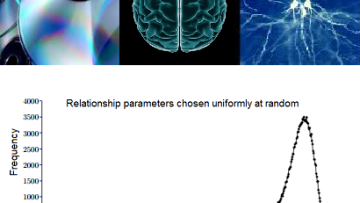11:00
11:00
Single Valued Elliptic Multizetas and String theory
Abstract
Modular invariance is ubiquitous in string theory. This is the symmetry of genus-one amplitudes, as well as the non-perturbative duality symmetry of type IIb superstring in ten dimensions. The alpha’ expansion of string theory amplitudes leads to interesting new modular forms. In this talk we will describe the properties of the new modular forms. We will explain that the modular forms entering the alpha’ expansion of genus one type-II superstring amplitude are naturally expressed as particular values of single valued elliptic multiple polylogarithm. They are natural modular generalization of the single valued elliptic multiple-zeta introduced by Francis Brown.
How a complex dynamic network such as the human brain gives rise to consciousness has yet to be established by science. A popular view among many neuroscientists is that, through a variety of learning paradigms, the brain builds relationships and in the context of these relationships a brain state acquires meaning in the form of the relational content of the corresponding experience.
The Manin-Mumford Conjecture via O-minimality
Abstract
In the talk I will give an introduction to the Manin-Mumford conjecture and to the Pila-Zannier strategy for attacking it in the case of products of elliptic curves. if the permits it, I will also speak about how this same strategy has allowed to attack the analogous André-Oort conjecture for Shimura Varieties of abelian type.
14:30
How accurate must solves be in interior point methods?
Abstract
At the heart of the interior point method in optimization is a linear system solve, but how accurate must this solve be? The behaviour of such methods is well-understood when a direct solver is used, but the scale of problems being tackled today means that users increasingly turn to iterative methods to approximate its solution. Current suggestions of the accuracy required can be seen to be too stringent, leading to inefficiency.
In this talk I will give conditions on the accuracy of the solution in order to guarantee the inexact interior point method converges at the same rate as if there was an exact solve. These conditions can be shown numerically to be tight, in that performance degrades rapidly if a weaker condition is used. Finally, I will describe how the norms that appear in these condition are related to the natural norms that are minimized in several popular Krylov subspace methods. This, in turn, could help in the development of new preconditioners in this important field.
14:15
Generalized Kähler structures from a holomorphic Poisson viewpoint
Abstract
After reviewing the main results relating holomorphic Poisson geometry to generalized Kahler structures, I will explain some recent progress in deforming generalized Kahler structures. I will also describe a new way to view generalized kahler geometry purely in terms of Poisson structures.


